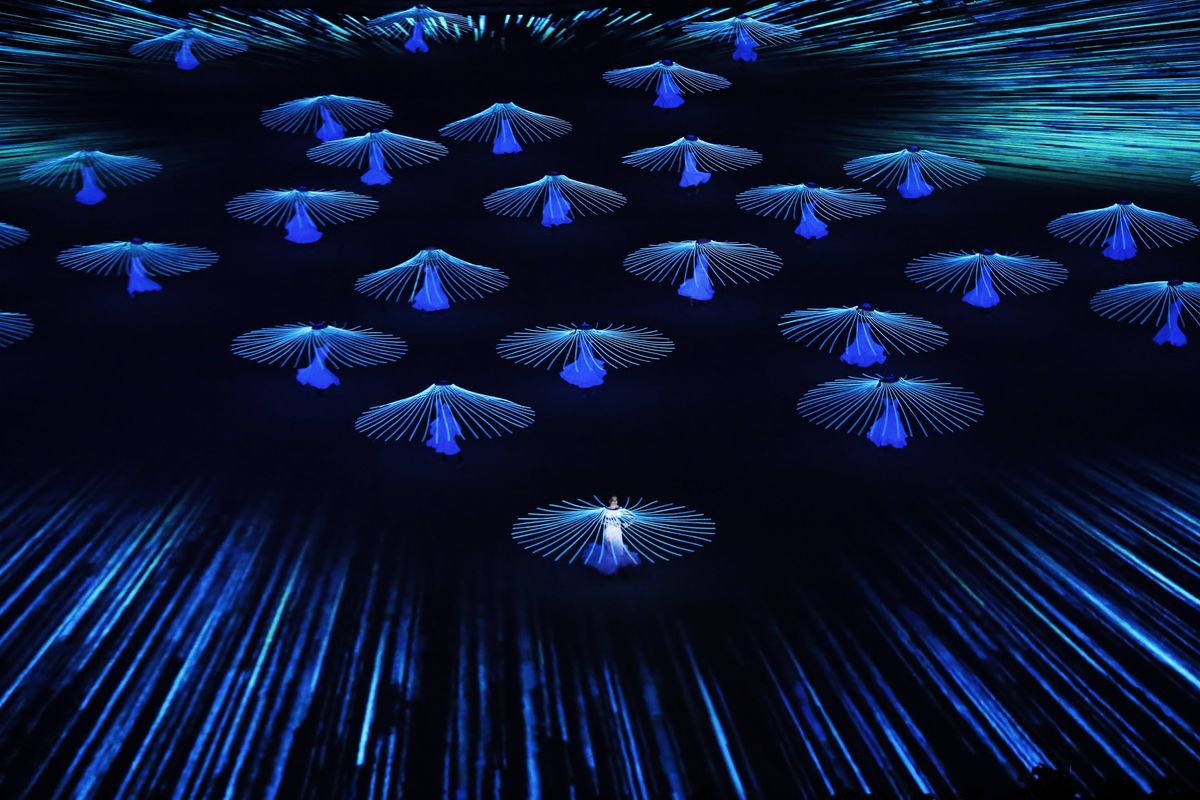Russia opens Games with party by the sea
Grand beginning casts aside fears, imperfections

SOCHI, Russia – For three hours Friday night, the translucent plastic bubble that soars over the magnificent new Fisht Stadium protected the 3,000 athletes and 40,000 fans from all the negativity that dominated the buildup to the 2014 Winter Olympics.
As they enjoyed an opening ceremony that aimed to show the world Russia’s post-Soviet identity, their minds surely were transported from unfinished hotel rooms, stray dogs, anti-gay laws and fears of terrorism.
Most people in the building probably didn’t even realize that just as the ceremony was getting started, a Ukrainian man attempted to hijack a Turkey-bound Pegasus Airlines plane and divert it to Sochi, saying there was a bomb on board. Turkish military jets forced the plane to land in Istanbul.
It was just another reminder of the security concerns surrounding the Games, but the news did not spoil this seaside party at the foot of the Caucasus mountains. The only glitch of the night was when one of five flying Olympic rings didn’t open properly.
Fireworks blasted inside and outside the stadium when the shoehorn-shaped cauldron was lit in the center of the Olympic park. It will burn there for the next 17 days as athletes from 88 countries compete in 15 sports. Hockey legend Vladislav Tretiak and figure skater Irina Rodnina lit the torch, a nod to two of this country’s most beloved sports.
The Russians did not try to oversize the magnificent Beijing ceremony of 2008 or outwit the clever, star-studded ceremony of London in 2012. They stuck to what they do best: classical music, ballet, literature, folk art and architectural wonders such as the colorful onion spires of St. Basil’s Cathedral.
Instead of OneDirection, they played Tchaikovsky, although they did have a military choir do a surprisingly good rendition of Daft Punk’s “Get Lucky” in the preceremony show.
Instead of James Bond, they featured famous ballet dancers bringing to life a ballroom scene from Leo Tolstoy’s 1,200-page novel “War and Peace.”
Russian President Vladimir Putin did not leap out of a helicopter, as the queen of England (sort of) did at the opening of the London Summer Olympics in 2012. Putin entered his box through a door, wearing a dark business suit.
“When we set out on this journey, we tried to open the doors to the future to break down stereotypes to reveal a new Russia to the world,” said Dmitry Chernychenko, president of the Sochi Organizing Committee. “Today, the future is here.”
He then explained the motto of these Olympics: Hot. Cool. Yours.
“Our Games will be hot. Not only because of the palm trees outside the ice arenas, but also because of the heat in our hearts. Our Games will be cool with new modern sports, new heroes, new icons. Our Games will be yours. All of yours. Because when we come together in all our diversity, it is the Olympic Games that unite us.”
The most anticipated part of the ceremony, the Parade of Nations, included a unique wrinkle. Instead of entering the stadium from side tunnels, athletes emerged from an underground ramp in the center of the stage while a map of the world was projected onto the stadium floor. Each country was highlighted on the map when it was announced.
As always, there was a wide array of fashion choices. Bermuda’s small team came dressed, of course, in Bermuda shorts and blazers. Jamaica’s team, which features its lovable famous bobsled team, was wearing uniforms designed by Bob Marley’s daughter, Cedella. The New Zealanders looked most comfy in their fuzzy onesies.
Germany has gotten attention for its rainbow-striped jackets, but team officials insisted the color selection was not a political statement against Putin’s anti-gay laws, but rather a tribute to Sochi’s turquoise sea, white snow and yellow sun.
The athletes settled into their seats to enjoy the rest of the show.
The history of Russia was told through the dreams of a young girl named Lubov, which translates to “love.” Her journey began with an examination of the vast size of Russia – a country that spans 6.6 million square miles and nine time zones. Floating in the air from one end of the stadium to the other were images of the twinkling lights of the Aurora Borealis, the subtropics of Sochi and the Ural Mountains.
Then there was a chronology of historical figures that shaped the country. It began with a giant illuminated troika – a carriage pulled by three horses, the iconic Russian symbol of courage – flying across the stadium.
Next came the most colorful and fanciful part of the show. Gigantic, inflatable, colorful onion spires like those of St. Basil’s Cathedral came dancing onto the stage.
One number featured Russian folk art, a colorful street circus, and a tribute to “Maslenitsa” (Pancake Week). Maslenitsa is an Eastern Slavic religious and folk holiday that is celebrated seven weeks before Easter, the last week before Lent. It celebrates, among other things, the end of winter, so traditions include sledding and snowball fights, and eating “bliny” pancakes – a symbol of buttery treats that are given up during Lent.
Peter the Great was represented by a diorama of his army and the Russian Revolution was depicted with huge, dramatic, flying sculptures and many pieces of avant garde art. Modern Russia came to life with cosmonauts and construction workers.
On this night, the focus was not on issues or problems; it was a party to celebrate Russia’s newest winter sports playground.
“These are the first-ever Olympic Games organized in the new Russia,” said Thomas Bach, president of the International Olympic Committee. “The Russians’ deep desire for their own winter sport resort was so great because of their passion for sports on snow and ice. What took decades in other parts of the world has been achieved here in just seven years. This is a remarkable achievement.”